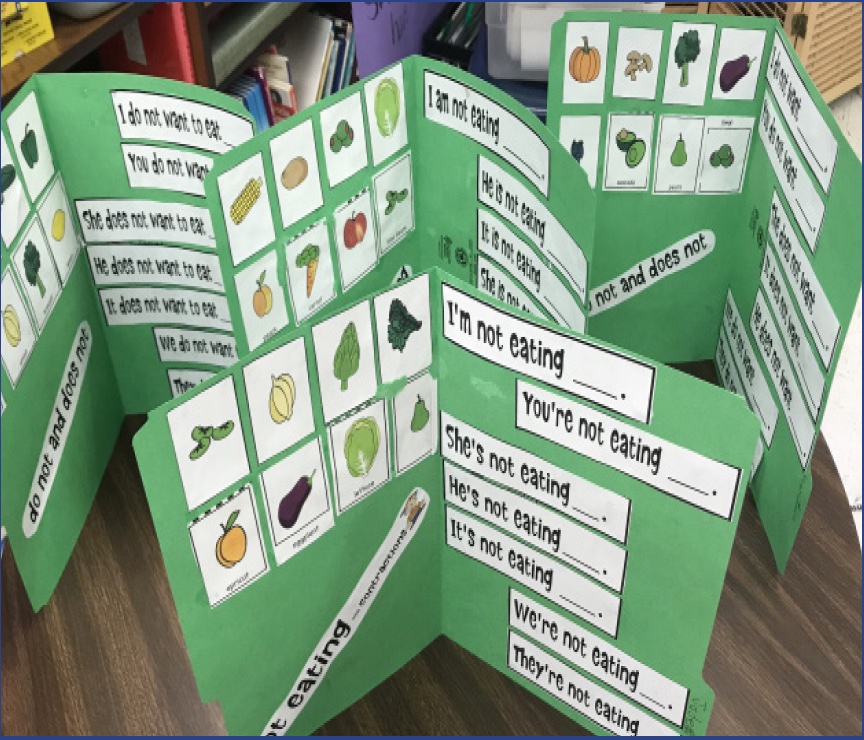Here comes May!

As teachers, we know that teaching English as a Second Language (ESL) to newcomers requires lessons at each language domain – speaking, listening, reading, and writing. In this blog post, we’ll explore strategies for teaching ESL newcomers in May, focusing on essential grammar skills needed at the beginning level of English proficiency.
Grammar Skills
When teaching English Newcomers at the beginning level of English language learning, focus on reinforcing grammar skills through the lens of food-related contexts. Teach basic sentence structures using verbs like want, don’t want, and do not want to express preferences. Introduce present progressive to describe ongoing actions related to food, such as “She is cooking dinner” or “They are tasting the soup.” Incorporate food vocabulary into grammar exercises, asking students to complete sentences with appropriate words. For example, “I _____ to try new recipes” or “She _____ like spicy food.”

Provide opportunities for practice and reinforcement through interactive activities, role-plays, and games centered around food themes. By integrating grammar instruction with food-related content, you can engage students while strengthening their language skills in a relevant and meaningful context.
Speaking
May provides an opportunity for ESL instructors to engage newcomers in speaking activities reflecting the season’s energy and enthusiasm. Encourage students to express what they want to eat during springtime picnics or barbecues. Role-plays can involve ordering food at a restaurant or sharing preferences for seasonal dishes. Group discussions can explore different foods that students enjoy or don’t enjoy. For example, “What foods do you want to try this spring?” or “Who doesn’t want to eat salads?” Use present progressive to describe ongoing actions, such as “I am enjoying fresh fruit” or “She is trying new recipes.”

Incorporate food vocabulary like fruits, vegetables, meats, and beverages to enrich conversations and expand vocabulary. This approach not only enhances speaking skills but also makes learning enjoyable and relevant to students’ interests.
Listening
Listening comprehension plays a pivotal role in ESL learners’ ability to understand spoken English in various contexts. In May, utilize themed audio materials such as cooking shows, food podcasts, or conversations about dining experiences to engage students. Incorporate listening tasks that involve identifying what people want to eat or don’t want to eat during the spring season. For instance, listen to a dialogue where someone is discussing their favorite foods for a picnic or a barbecue.

Use present progressive to describe ongoing actions, such as “They are trying a new recipe” or “He is preparing a salad.” Encourage students to listen for food vocabulary and expressions related to preferences, such as “I want to try sushi” or “She doesn’t want to eat spicy food.” By integrating food-related content into listening activities, students can enhance their comprehension skills while expanding their vocabulary in a meaningful context.
Reading
Introduce ESL newcomers to engaging texts that explore the culinary delights of the spring season. Select articles or stories that discuss seasonal foods, cooking traditions, and culinary adventures. Encourage students to read actively, identifying what characters want to eat or don’t want to eat. For example, a passage might describe a character’s craving for fresh fruit or their aversion to spicy dishes.

Use present progressive to describe cooking activities, such as “She is preparing a salad” or “They are trying a new recipe.” Scaffold reading activities to include food vocabulary, such as ingredients, cooking methods, and meal preferences. By immersing students in texts that celebrate food culture, you can foster comprehension skills while enriching their vocabulary in a deliciously engaging way.
Writing
In May, inspire ESL newcomers to express their culinary experiences and preferences through writing. Assign writing tasks that invite students to describe what they want to eat or don’t want to eat during the spring season. Encourage them to use present progressive to narrate cooking adventures, such as “I am trying a new recipe” or “We are exploring different cuisines.” Provide prompts that stimulate creativity, such as composing a menu for a springtime picnic or writing a food diary detailing favorite dishes. Encourage the use of food vocabulary and descriptive language to enhance expression. By tapping into their passion for food, students can cultivate their writing skills while savoring the joy of self-expression.

Have fun this May teaching ESL Newcomers. By integrating speaking, listening, reading, and writing activities aligned with springtime themes, instructors can create immersive learning experiences that inspire curiosity, creativity, and cultural appreciation. With a focus on essential grammar skills, ESL educators can empower newcomers to communicate confidently and effectively in English, paving the way for continued growth and success in their language acquisition journey. Check out my ESL Bundle for May which includes resources for English Newcomers and all ESL levels.
Looking for time-saving tips and tricks for teaching math and ESL? Sign up for my email newsletter to get free teaching resources and helpful strategies right to your inbox! Click here to sign up.

Need an organized curriculum for your ESL students for an entire year? We have you covered!

No comments:
Post a Comment